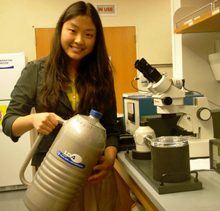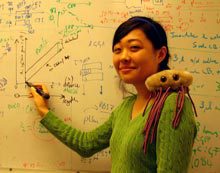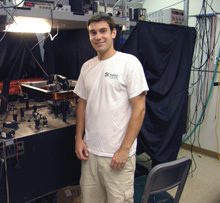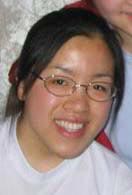Alexandra Carstensen

How does the brain represent concepts outside of perceptual experience? Relatively little is known about the neural mechanisms and brain areas involved in abstract thoughtthose enabling us to conceptualize domains for which we lack dedicated perceptual systems. Theories of embodied cognition suggest that understandings of such abstract domains are constructed from co-experienced perceptual input; for instance, Lakoff & Johnson (1999) have proposed that we build representations of time based on experiences of movement through space, as we consistently experience the passage of time while moving. This research seeks to determine […]
Elaine Liu

My project seeks to solve the structure of the binding interaction between Mb11 and -tubulin in microtubules. Microtubules are dynamic cytoskeletal polymers essential to life, composed of tubulin subunits, heterodimers of – and -tubulin, which align longitudinally into linear protofilaments and assemble laterally into a cylinder, forming the microtubule. Mb11 is an antibody that has been found to bind specifically to tubulin in the GTP bound conformation. In contrast to GDP bound tubulin, GTP-bound tubulin is straighter and more stable. This difference allows for the specific recognition of the antibody […]
Anita Satish

Research has shown that memory for medical and psychological advice hovers between 20 and 30 percent. This may be associated with adverse effects on treatment adherence and outcomes. My research employs memory-enhancing strategies through a reiterative text-message intervention for cognitive behavioral therapy (CBT). Previous research suggests text interventions can have positive treatment outcomes. A more standardized and systematic approach to studying their effects on treatment outcomes and memory, may lead to more conclusive findings. In my study, participants will receive a two-week text-message intervention following a basic lesson in CBT, […]
Robert Bellerose

Biofuels have received much attention lately as the need for a renewable and carbon-neutral source of energy becomes increasingly important. We have assembled a biosynthetic pathway in Escherichia coli that produces butanol, a second generation biofuel, in six overall steps. However, there is a significant bottleneck at crotonyl-CoA reductase (Ccr) in the pathway that limits butanol production, which may be attributed to the observation that Ccr suffers from low solubility. The overall goal of my project is to carry out directed evolution of Ccr and generate a library of mutants […]
Lusha Liang

In bacterial genomes, functionally related genes tend to be grouped together in operons, possibly to facilitate co-regulation and coordinated horizontal gene transfer. However, co-regulation and the formation of selfish gene clusters cannot explain the co-localization of regulators and their target operons. Yet this co-localization of prokaryotic transcription factor genes and their binding sites is widespread and is a driving force in the specific organization of transcriptional units on the chromosome. Thus in this study I will use the paradigmatic model of gene regulation, the lac locus, to address a fundamental […]
Yannan Shen

Type II topoisomerases are enzymes that can change the topology of circular DNA molecules. These enzymes are essential to every living organism, which makes them good targets for anti-cancer and anti-bacterial drugs. DNA topology assays are used to determine the efficiency of topoisomerase inhibitors in drug design. In my research, I focus on the unknotting probability of knots by type II topoisomerases. In our previous study, our group built a mathematical model in simple cubic lattice to simulate how random strand passages generate the knotting distribution. We intended to use […]
Lucas Zipp

Diamond magnetometry works by probing the electron spin resonances of the nitrogen-vacancy (NV) centers in diamond. An NV center is a defect in the diamond crystal structure in which a nitrogen atom is located next to a hole in the lattice structure. An external magnetic field causes a shift in the electron spin energy levels of the NV centers. Using lasers and microwaves, we can manipulate the electron quantum spin states to detect this shift. My goal this summer is to examine the NV defects in diamond with nanometer scale […]
Leslie Chung-Lei Sheu
Mycobacterium tuberculosis (M.tb), along with other infectious diseases, has become a resurgent global concern, in part due to selection for drug-resistant strains in infected populations. M.tb is able to survive within macrophages (innate immune cells that should engulf and degrade foreign material) in compartments known as phagosomes by some unknown mechanism. This summer, I want to use quantitative mass spectrometry to study how specific cell wall glycolipids of M.tb manipulate phagosomal membrane protein expression in macrophage cells. By comparing protein regulation by two structurally similar but functionally very different glycolipids […]
Stephanie Byun

Sorghum is an important staple crop in the semi-arid tropics of Asia and Africa as it feeds millions of the poorest people in these regions. It provides some degree of nutritional content for humans, but is considered an inferior grain because of its significantly lowered protein digestion. Since sorghum is being consumed in populations where undernourishment is of concern, it is extremely important to consider the accessibility of its nutritional content.
Janet Luo

The importance of studying genetic variants in humans has given rise to the worldwide HapMap Project, which can potentially lead to techniques to diagnose, treat, or prevent illnesses according to each persons different genetic makeup, thus enhancing efficacy. This project tests a method to identify crossover breakpoint regions at a higher resolution than previous studies have. Because single nucleotide polymorphisms are bi-allele, their limited number of states can be analyzed case by case in advance; studying families of three generations using tri-trio pedigree charts allows for the deduction of information […]